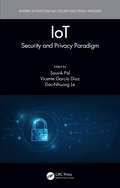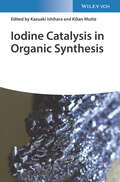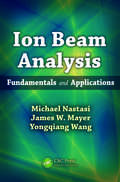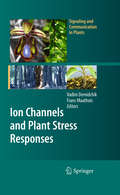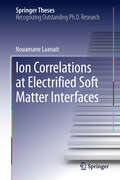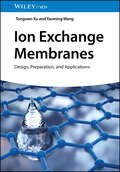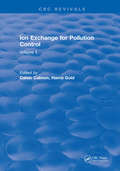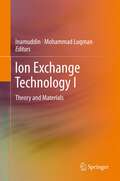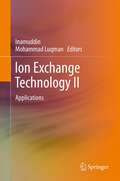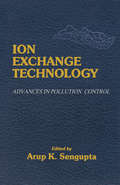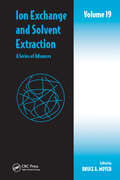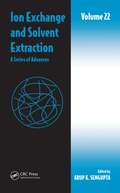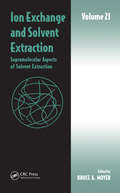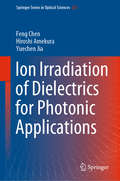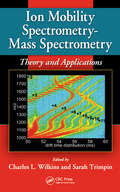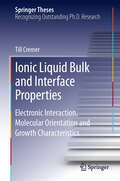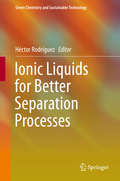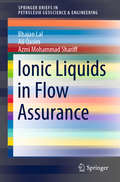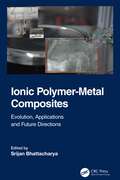- Table View
- List View
IoT: Security and Privacy Paradigm (Internet of Everything (IoE) #63)
by Dac-Nhuong Le Vicente García Díaz Souvik PalIOT: Security and Privacy Paradigm covers the evolution of security and privacy issues in the Internet of Things (IoT). It focuses on bringing all security and privacy related technologies into one source, so that students, researchers, and practitioners can refer to this book for easy understanding of IoT security and privacy issues. This edited book uses Security Engineering and Privacy-by-Design principles to design a secure IoT ecosystem and to implement cyber-security solutions. This book takes the readers on a journey that begins with understanding the security issues in IoT-enabled technologies and how it can be applied in various aspects. It walks readers through engaging with security challenges and builds a safe infrastructure for IoT devices. The book helps readers gain an understand of security architecture through IoT and describes the state of the art of IoT countermeasures. It also differentiates security threats in IoT-enabled infrastructure from traditional ad hoc or infrastructural networks, and provides a comprehensive discussion on the security challenges and solutions in RFID, WSNs, in IoT. This book aims to provide the concepts of related technologies and novel findings of the researchers through its chapter organization. The primary audience includes specialists, researchers, graduate students, designers, experts and engineers who are focused on research and security related issues. Souvik Pal, PhD, has worked as Assistant Professor in Nalanda Institute of Technology, Bhubaneswar, and JIS College of Engineering, Kolkata (NAAC "A" Accredited College). He is the organizing Chair and Plenary Speaker of RICE Conference in Vietnam; and organizing co-convener of ICICIT, Tunisia. He has served in many conferences as chair, keynote speaker, and he also chaired international conference sessions and presented session talks internationally. His research area includes Cloud Computing, Big Data, Wireless Sensor Network (WSN), Internet of Things, and Data Analytics. Vicente García-Díaz, PhD, is an Associate Professor in the Department of Computer Science at the University of Oviedo (Languages and Computer Systems area). He is also the editor of several special issues in prestigious journals such as Scientific Programming and International Journal of Interactive Multimedia and Artificial Intelligence. His research interests include eLearning, machine learning and the use of domain specific languages in different areas. Dac-Nhuong Le, PhD, is Deputy-Head of Faculty of Information Technology, and Vice-Director of Information Technology Apply and Foreign Language Training Center, Haiphong University, Vietnam. His area of research includes: evaluation computing and approximate algorithms, network communication, security and vulnerability, network performance analysis and simulation, cloud computing, IoT and image processing in biomedical. Presently, he is serving on the editorial board of several international journals and has authored nine computer science books published by Springer, Wiley, CRC Press, Lambert Publication, and Scholar Press.
Iodine Catalysis in Organic Synthesis
by Kazuaki IshiharaIodine Catalysis in Organic Synthesis The first book of its kind to highlight iodine as a sustainable alternative to conventional transition metal catalysis Iodine Catalysis in Organic Synthesis provides detailed coverage of recent advances in iodine chemistry and catalysis, focusing on the utilization of various iodine-containing compounds as oxidative catalysts. Featuring contributions by an international panel of leading research chemists, this authoritative volume explores the development of environmentally benign organic reactions and summarizes catalytic transformations of molecular iodine and iodine compounds such as hypervalent organoiodine and inorganic iodine salts. Readers are first introduced to the history of iodine chemistry, the conceptual background of homogeneous catalysis, and the benefits of iodine catalysis in comparison with transition metals. Next, chapters organized by reaction type examine enantioselective transformations, catalytic reactions involving iodine, catalyst states, oxidation in iodine and iodine catalyses, and catalytic reactions based on halogen bonding. Practical case studies and real-world examples of different applications in organic synthesis and industry are incorporated throughout the text. An invaluable guide for synthetic chemists in both academic and industrial laboratories, Iodine Catalysis in Organic Synthesis: Provides a thorough overview of typical iodine-catalyzed reactions, catalyst systems, structures, and reactivity Explores promising industrial applications of iodine-based reagents for organic synthesis Highlights the advantages iodine catalysis has over classical metal-catalyzed reactions Discusses sustainable and eco-friendly methods in hypervalent iodine chemistry Edited by two world authorities on the catalytic applications of organoiodine compounds, Iodine Catalysis in Organic Synthesis is required reading for catalytic, organic, and organometallic chemists, medicinal and pharmaceutical chemists, industrial chemists, and academic researchers and advanced students in relevant fields.
Ion Beam Analysis: Fundamentals and Applications
by Michael Nastasi James W. Mayer Yongqiang WangIon Beam Analysis: Fundamentals and Applications explains the basic characteristics of ion beams as applied to the analysis of materials, as well as ion beam analysis (IBA) of art/archaeological objects. It focuses on the fundamentals and applications of ion beam methods of materials characterization.The book explains how ions interact with solids
Ion Beam Induced Defects and Their Effects in Oxide Materials (SpringerBriefs in Physics)
by Vinod Kumar Parmod Kumar Jitendra Pal Singh K. AsokanThis book provides an overview of the applications of ion beam techniques in oxide materials. Oxide materials exhibit defect-induced physical properties relevant to applications in sensing, optoelectronics and spintronics. Defects in these oxide materials also lead to magnetism in non-magnetic materials or to a change of magnetic ordering in magnetic materials. Thus, an understanding of defects is of immense importance. To date, ion beam tools are considered the most effective techniques for producing controlled defects in these oxides. This book will detail the ion beam tools utilized for creating defects in oxides.
Ion Beams in Materials Processing and Analysis
by Klaus Wetzig Bernd SchmidtA comprehensive review of ion beam application in modern materials research is provided, including the basics of ion beam physics and technology. The physics of ion-solid interactions for ion implantation, ion beam synthesis, sputtering and nano-patterning is treated in detail. Its applications in materials research, development and analysis, developments of special techniques and interaction mechanisms of ion beams with solid state matter result in the optimization of new material properties, which are discussed thoroughly. Solid-state properties optimization for functional materials such as doped semiconductors and metal layers for nano-electronics, metal alloys, and nano-patterned surfaces is demonstrated. The ion beam is an important tool for both materials processing and analysis. Researchers engaged in solid-state physics and materials research, engineers and technologists in the field of modern functional materials will welcome this text.
Ion Channels and Plant Stress Responses
by Frans J.M. Maathuis Vadim DemidchikThis book aims to provide a range of perspectives on an area that is very topical at present in plant biology: the role of ion channels in plant stress responses. Functions of cation and anion channels in the sensing and encoding of major biotic and abiotic stimuli, stress signal transduction and metabolism adjustment are examined at the cellular and molecular levels. Particular emphases of the book are on new insights into plant Ca2+ signaling, salinity tolerance mechanisms, cyclic nucleotide gated channels and the regulation of stress reactions among oxygen-derived species.
Ion Correlations at Electrified Soft Matter Interfaces
by Nouamane LaanaitIon Correlations at Electrified Soft Matter Interfaces presents an investigation that combines experiments, theory, and computer simulations to demonstrate that the interdependency between ion correlations and other ion interactions in solution can explain the distribution of ions near an electrified liquid/liquid interface. The properties of this interface are exploited to vary the coupling strength of ion-ion correlations from weak to strong while monitoring their influence on ion distributions at the nanometer scale with X-ray reflectivity and on the macroscopic scale with interfacial tension measurements. This thesis demonstrates that a parameter-free density functional theory that includes ion-ion correlations and ion-solvent interactions is in agreement with the data over the entire range of experimentally tunable correlation coupling strengths. The reported findings represent a significant advance towards understanding the nature and role of ion correlations in charged soft-matter. Ion distributions underlie many scientific phenomena and technological applications, including electrostatic interactions between charged biomolecules and the efficiency of energy storage devices. These distributions are determined by interactions dictated by the chemical properties of the ions and their environment, as well as the long-range nature of the electrostatic force. The presence of strong correlations between ions is responsible for counterintuitive effects such as like-charge attraction.
Ion Exchange Membranes: Design, Preparation, and Applications
by Tongwen Xu Yaoming WangIon Exchange Membranes A comprehensive introduction to the electro-membrane technologies of the future An ion exchange membrane is a polymer-based membrane which can be permeable by some ions in a solution while blocking others, making them ideal for processes such as water desalination, salt concentration control, clean production and—given their electrical conductivity—power generation and energy storage etc. Recent advances have given rise to new electro-membrane processes that promise drastically to expand the applications of this technology. Scientists in both research and industry will increasingly need to draw on these membranes in vital ways with strongly positive potential environmental impact. Ion Exchange Membranes summarizes recent research into these membranes and electro-membrane processes before moving to an overview of the historical background. It then attends in detail to cutting-edge fabrication technologies and the most recent areas of use. The result is a comprehensive introduction to the design, fabrication, and applications of these increasingly essential membranes. Ion Exchange Membranes readers will also find: In-depth treatment of industrial-scale applications Detailed discussion of topics including side-chain engineering, polyacylation, superacid-catalyst polymerization, and more Analysis of electro-membrane processes such as alkaline membrane water electrolysis, solar-driven water splitting, and many more Ion Exchange Membranes is ideal for membrane scientists, materials scientists, inorganic chemists, polymer chemists, and researchers and engineers in a variety of fields working with ion exchange membranes and electro-membrane processes.
Ion Exchange Pollution Control: Volume II
by C. CalmonThe aim of these volumes is not to cover all phases of ion-exchange theory, which may be found in general texts, nor to cover every application in the literature, or to show an engineer ways on how to become an expert in the field so he coulddo it all by himself. The main purpose of these books is to show the practical engineer what has been done in various types of applications of ion-exchange processes in pollution control, how to set up laboratory tests, the problems that may be encountered to identify the individuals and organizations who are experts in the various phases of ion exchange, and most importantly, to emphasize the new developments in the polymers with active sites that offer new approaches to wastewater treatment methods.
Ion Exchange Technology I
by Mohammad Luqman Inamuddin Dr.Ion-exchange Technology I: Theory and Materials describes the theoretical principles of ion-exchange processes. More specifically, this volume focuses on the synthesis, characterization, and modelling of ion-exchange materials and their associated kinetics and equilibria. This title is a highly valuable source not only to postgraduate students and researchers but also to industrial R&D specialists in chemistry, chemical, and biochemical technology as well as to engineers and industrialists.
Ion Exchange Technology II
by Dr Inamuddin Mohammad LuqmanIon-exchange Technology II: Applications presents an overview of the numerous industrial applications of ion-exchange materials. In particular, this volume focuses on the use of ion-exchange materials in various fields including chemical and biochemical separations, water purification, biomedical science, toxic metal recovery and concentration, waste water treatment, catalysis, alcohol beverage, sugar and milk technologies, pharmaceuticals industry and metallurgical industries. This title is a highly valuable source not only to postgraduate students and researchers but also to industrial R&D specialists in chemistry, chemical, and biochemical technology as well as to engineers and industrialists.
Ion Exchange Technology: Advances in Pollution Control
by Arup K. SenGuptaThis book provides comprehensive coverage of developments in ion exchange areas which would continue to have major impacts in the general pursuit of pollution control and pollution prevention. Its nine chapters can be split into four different theme areas: trace contaminants removals; new materials; desalination and finally controlling gaseous pollutants. This would have value for practicing engineers, scientists and researchers who are pertaining to ion exchange technology. It would also server the needs of those trying to explore and identify new technologies in the areas of pollution control and pollution prevention.
Ion Exchange and Solvent Extraction: A Series of Advances, Volume 19 (Ion Exchange and Solvent Extraction Series)
by Bruíea. MoyerThe growth in the world's nuclear industry, motivated by peaking world oil supplies, concerns about the greenhouse effect, and domestic needs for energy independence, has resulted in a heightened focus on the need for next-generation nuclear fuel-cycle technologies. Ion Exchange and Solvent Extraction: A Series of Advances, Volume 19 provides a com
Ion Exchange and Solvent Extraction: A Series of Advances, Volume 22 (Ion Exchange and Solvent Extraction Series #Vol. 16)
by Arup K. SenguptaSince the Second World War, the field of ion exchange has taken a dominant role in offering solutions to many problems in the developed and developing world. It has evolved to a wide array of applications, including mining, microelectronics, drug delivery and detection, food, fertilizers, chemical cleaning, catalysis, bioseparation, water management, environmental research and practices, and energy. The six chapters in this book represent diverse contributions from researchers around the globe who are making noticeable strides in the field in currently important areas: Brackish water desalination Removing boron from water Sustainable approaches for synthesizing commercially important epoxide building blocks Solid-phase heavy-metal separation Separating concentrated ion mixtures in sorption columns Sensing toxic metals Ion Exchange and Solvent Extraction: A Series of Advances, Volume 22 provides a focused review of new materials and new processes that have developed and are rapidly growing. It describes cutting-edge research and practices in the use of ion exchange for building a cleaner, sustainable world and provides thoughtful insights on what ion exchange may do for us in the future.
Ion Exchange and Solvent Extraction: Volume 21, Supramolecular Aspects of Solvent Extraction
by Bruce A. MoyerOver the past several decades, the theme of supramolecular chemistry (SC) has permeated nearly all aspects of chemical endeavor. Not surprisingly, it has also pervaded the field of solvent extraction (SX), inspiring the framework for this volume of Ion Exchange and Solvent Extraction. In addition, tools for studying aggregation have grown increasin
Ion Exchange in Environmental Processes: Fundamentals, Applications and Sustainable Technology
by Arup K. SenguptaProvides a comprehensive introduction to ion exchange for beginners and in-depth coverage of the latest advances for those already in the field As environmental and energy related regulations have grown, ion exchange has assumed a dominant role in offering solutions to many concurrent problems both in the developed and the developing world. Written by an internationally acknowledged leader in ion exchange research and innovation, Ion Exchange: in Environmental Processes is both a comprehensive introduction to the science behind ion exchange and an expert assessment of the latest ion exchange technologies. Its purpose is to provide a valuable reference and learning tool for virtually anyone working in ion exchange or interested in becoming involved in that incredibly fertile field. Written for beginners as well as those already working the in the field, Dr. SenGupta provides stepwise coverage, advancing from ion exchange fundamentals to trace ion exchange through the emerging area of hybrid ion exchange nanotechnology (or polymeric/inorganic ion exchangers). Other topics covered include ion exchange kinetics, sorption and desorption of metals and ligands, solid-phase and gas-phase ion exchange, and more. Connects state-of-the-art innovations in such a way as to help researchers and process scientists get a clear picture of how ion exchange fundamentals can lead to new applications Covers the design of selective or smart ion exchangers for targeted applications—an area of increasing importance—including solid and gas phase ion exchange processes Provides in-depth discussion on intraparticle diffusion controlled kinetics for selective ion exchange Features a chapter devoted to exciting developments in the areas of hybrid ion exchange nanotechnology or polymeric/inorganic ion exchangers Written for those just entering the field of ion exchange as well as those involved in developing the “next big thing” in ion exchange systems, Ion Exchange in Environmental Processes is a valuable resource for students, process engineers, and chemists working in an array of industries, including mining, microelectronics, pharmaceuticals, energy, and wastewater treatment, to name just a few.
Ion Irradiation of Dielectrics for Photonic Applications (Springer Series in Optical Sciences #231)
by Feng Chen Hiroshi Amekura Yuechen JiaThis book focuses on the fundamentals, technologies and properties of ion irradiation of dielectric materials (e.g. glasses, crystals) with regard to various photonic applications. It introduces readers to diverse ion-beam techniques for the fabrication and modification of micron- or nanoscale photonic structures, including optical waveguides, photonic crystals, and nanoparticle (nano-spheres and nano-rods) systems, and presents state-of-the-art advances in this multi-disciplinary research field, demonstrating the unique capabilities of ion-beam technologies in optical dielectric materials processing. The book discusses in detail the properties of ion-beam processed waveguides, as well as the modification of dielectrics for photonic applications, such as electro-optic modulation, nonlinear frequency conversion, waveguide amplification and lasing. It also explores synthesis and the correlated optical effects of nanoparticles by ion beams, and features examples of successful micro- and nano-photonic devices. Given its breadth of coverage, the book will particularly appeal to readers interested in ion-beam technology, materials science, and integrated optics.
Ion Mobility Spectrometry - Mass Spectrometry: Theory and Applications
by Charles L. Wilkins Sarah TrimpinThe analytical power of ion mobility spectrometry-mass spectrometry (IMS-MS) instruments is poised to advance this technology from research to analytical laboratories. Exploring these developments at this critical juncture, Ion Mobility Spectrometry-Mass Spectrometry: Theory and Applications covers the tools, techniques, and applications involved when molecular size and shape information is combined with the well-known analytical advantages of high-performance mass spectrometry.One of the Most Exciting Developments in Contemporary Mass SpectrometryAfter presenting an overview chapter and the fundamentals, the book focuses on instrumentation and ionization sources. It describes an ion-mobility-capable quadrupole time-of-flight mass spectrometer, the differential mobility analyzer, a cryogenic-temperature ion mobility mass spectrometer, the atmospheric solids analysis probe method, and laserspray ionization. In the final applications-oriented chapters, the contributors explore how homebuilt and commercial instruments using electrospray ionization and matrix-assisted laser desorption/ionization (MALDI) methods are employed to solve biological and synthetic issues.Harness the Power of IMS-MS for Analyzing Complex SubstancesThis work helps readers unfamiliar with IMS-MS to understand its fundamental theory and practical applications. It also encourages them to investigate the potential analytical uses of IMS-MS and further explore the power of this method. Numerous color figures are included on downloadable resources.
Ion acceleration and extreme light field generation based on ultra-short and ultra-intense lasers
by Liangliang JiThis book is dedicated to the relativistic (laser intensity above 1018 W/cm2) laser-plasma interactions, which mainly concerns two important aspects: ion acceleration and extreme-light-field (ELF). Based on the ultra-intense and ultra-short CP lasers, this book proposes a new method that significantly improves the efficiency of heavy-ion acceleration, and deals with the critical thickness issues of light pressure acceleration. More importantly, a series of plasma approaches for producing ELFs, such as the relativistic single-cycle laser pulse, the intense broad-spectrum chirped laser pulse and the ultra-intense isolated attosecond (10-18s) pulse are introduced. This book illustrates that plasma not only affords a tremendous accelerating gradient for ion acceleration but also serves as a novel medium for ELF generation, and hence has the potential of plasma-based optics, which have a great advantage on the light intensity due to the absence of device damage threshold.
Ion-Selective Electrodes
by Konstantin N. MikhelsonIon-selective electrodes (ISEs) have a wide range of applications in clinical, environmental, food and pharmaceutical analysis as well as further uses in chemistry and life sciences. Based on his profound experience as a researcher in ISEs and a course instructor, the author summarizes current knowledge for advanced teaching and training purposes with a particular focus on ionophore-based ISEs. Coverage includes the basics of measuring with ISEs, essential membrane potential theory and a comprehensive overview of the various classes of ion-selective electrodes. The principles of constructing ISEs are outlined, and the transfer of methods into routine analysis is considered. Advanced students, researchers, and practitioners will benefit from this expedient introduction.
Ionic Liquid Bulk and Interface Properties
by Till CremerIn this thesis, Till Cremer investigates the bulk properties of ionic liquids (IL), the IL/vacuum interface and the IL/solid interface. For these studies the author primarily uses angle-resolved X-ray photoelectron spectroscopy under ultrahigh vacuum conditions. ILs represent a class of materials with unique physico-chemical properties. Many applications take advantage of the extremely low vapor pressure of aprotic ILs to fabricate permanent, non-volatile liquid coatings on solid materials. The author focuses on issues related to thin IL coatings, in particular concerning new catalytic concepts such as the supported ionic liquid phase (SILP) and solid catalyst with ionic liquid layer (SCILL) systems. Till Cremer presents a number of fundamental contributions to the new field of "Ionic Liquid Surface and Interface Science". Highlights are his results concerning anion/cation-interactions and the growth of ultrathin layers of ionic liquids on various substrates in the context of supported ionic liquid catalysis. His results have significantly contributed to the present level of understanding in the field and accordingly he is author and coauthor of ten publications on the topic in high-ranked journals.
Ionic Liquid Catalyzed Reactions: Green Concepts and Sustainable Applications
by Zhimin Liu Yanfei ZhaoUnderstand the applications of ionic liquid catalysis with this cutting-edge overview Ionic liquids have distinctive properties that have made them the subject of vigorous research in recent decades. They have primarily been seen as potential green alternatives to volatile organic solvents, and therefore as a vital tool in the development of sustainable industry. In fact, however, ionic liquids can also serve as catalysts, catalyst immobilizers, and initiators, with the result that they have been applied in over 100 known types of chemical reactions. Ionic Liquid Catalyzed Reactions: Green Concepts and Sustainable Applications offers a detailed overview of these reactions and the catalytic mechanism of ionic liquids. It surveys cutting-edge research into ionic liquid catalysis and the concepts, perspectives, and skills needed for scientists to incorporate it into a range of experimental fields. It is a must-own for anyone looking to understand the range and variety of uses for ionic liquid catalysis. Ionic Liquid Catalyzed Reactions readers will also find: Case studies throughout showing ionic liquid catalysis applications Information for scientists working in organic chemistry, electrochemistry, biotechnology, and many more Detailed coverage of reactions including CO2 conversion, biomass transformation, organic synthesis, and many others Ionic Liquid Catalyzed Reactions is ideal for catalytic chemists, organic chemists, environmental chemists, electrochemists, and anyone else working with chemical catalysis in need of new experimental methods.
Ionic Liquids for Better Separation Processes
by Héctor RodríguezThis book discusses capital separation processes of industrial interest and explores the potential for substantial improvement offered by a promising class of substances: ionic liquids. These low melting point salts, with their unique characteristics, have been gaining relevance in the field of separation through a variety of approaches. The chapters are structured from an application perspective, and cover the utilisation of ionic liquids in different unit operation contexts (distillation, liquid-liquid extraction, and solid-liquid extraction), giving an idea of their remarkable versatility. The final chapters focus on the use of ionic liquids in analytical applications based on separation procedures. This volume combines the review of the main advances to date with the analysis of the potential future use of ionic liquids in separation processes across a variety of fields, ranging from enhancement of state-of-the-art technologies to a revolution in the technological bases currently in use. It provides a valuable resource for engineers and scientists working in the field of separation, as well as for all readers generally interested in ionic liquids, in particular from an application standpoint. Héctor Rodríguez is a faculty member of the Department of Chemical Engineering at the University of Santiago de Compostela, Spain.
Ionic Liquids in Flow Assurance (SpringerBriefs in Petroleum Geoscience & Engineering)
by Bhajan Lal Ali Qasim Azmi Mohammad ShariffThis book focuses on the application of ionic liquids in flow assurance in the oil and gas industry. It discusses their physiochemical properties, and considers the role of ionic liquids as gas hydrate inhibitors in offshore pipelines. Gas hydrate occurrence can pose a major threat to pipeline integrity. Therefore, different categories of gas hydrate inhibitors and the main factors influencing ionic liquids during gas hydrate inhibition are examined thoroughly. The use of ionic liquids as corrosion inhibitors, their application in flow assurance industry to mitigate corrosion, and factors affecting their performance are discussed. Finally, the applications of ionic liquids in wax, scale and asphaltenes deposition control is explored. The extensive discussion of ionic liquids in flow assurance mean that this book will be of use to researchers, engineers, and industry professionals in upstream processing of the oil and gas sector.
Ionic Polymer-Metal Composites: Evolution, Application and Future Directions
by Srijan BhattacharyaThis book focuses on electro active polymer material known as Ionic Polymer Metal Composite (IPMC) having unique applicability as sensor and actuator which finds extensive use in various domain of engineering and science research. Apart from fundamentals of the IPMC concept, various applications are covered extensively across the chapters including space, underwater and nanoscale, including manufacturing processes. Dedicated chapters are included for robotics and biomedical applications and possible research gaps. Future research perspectives for IPMC are also discussed. Features: Covers principle of Ionic Polymer Metal Composite (IPMC), manufacturing processes, applications, and future possibilities in a systematic manner Highlights IPMC practical applicability in biomedical engineering domain Explores Single-walled carbon nanotubes (SWNT) based IPMC soft actuators Discusses IPMC applications in underwater areas Includes IPMC application in robotics focusing on special compliant mechanism This book is aimed toward researchers, graduate students and professionals in materials and mechanical engineering, robotics, mechatronics, biomedical engineering, and physics.
